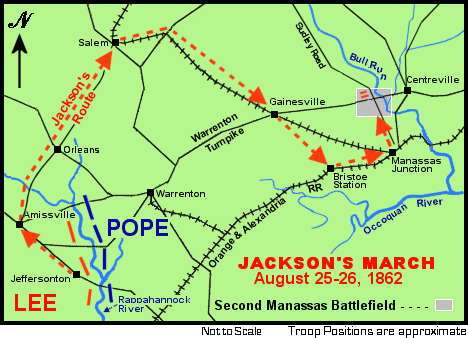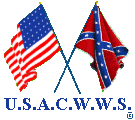
|
U. S. CIVIL WAR
PHOTOGRAPHS
|

|
FIRST AND SECOND
MANASSAS (BULL RUN)
PAGE TWO
To see the location of a photograph in this section click on the circled letter,
 ,
at the photograph. ,
at the photograph.
| |


Introduction to First Manassas (July 21, 1861)
This was to be the major battle of the war. Both the North and South thought that
a decisive victory at Manassas would cause the rapid collapse of the other side
and a rapid end to the War. To the Southerners, the Federal troops* marching
down the Warrenton Turnpike in Virginia, represented an invasion of their land.
To the Northerners, the troops were being sent to put down a rebellion, to keep
the Union intact, and to show the Rebel Leaders the hopelessness of their
situation. Hadn't President Lincoln bent over backwards to assuage the
differences over slavery? Surely with his reassurances and a sound whipping at
Manassas, the South would come back to its senses and to the fold.
*At the battle of First Manassas, the two Confederate Armies were called the "The Army of the Potomac" (under
Brigadier General P.G.T. Beauregard) and "The
Army of the Shenandoah (under General Joseph E. Johnston). The Union army
under Brigadier General Irvin McDowell was called "The Army of Northeastern
Virginia". Oddly enought, later in the war, "The Army of the Potomac" would
be a Union designation and the Confederate eastern army would be called the "Army
of Northern Virginia". were called the "The Army of the Potomac" (under
Brigadier General P.G.T. Beauregard) and "The
Army of the Shenandoah (under General Joseph E. Johnston). The Union army
under Brigadier General Irvin McDowell was called "The Army of Northeastern
Virginia". Oddly enought, later in the war, "The Army of the Potomac" would
be a Union designation and the Confederate eastern army would be called the "Army
of Northern Virginia".
GO TO FIRST MANASSAS
Introduction to Second Manassas (August 28-30, 1862)
With Union Gen. George B. McClellan and the Army of the Potomac bogged down on
the Virginia peninsula after the "Seven Days" battles, General John Pope was
placed in charge of an army composed of scattered Union units in Northern
Virginia. The new Union army was called "The Army of Virginia".
bogged down on
the Virginia peninsula after the "Seven Days" battles, General John Pope was
placed in charge of an army composed of scattered Union units in Northern
Virginia. The new Union army was called "The Army of Virginia".
While McClellan was still on the Peninsula, Confederate General
Robert E. Lee could not afford to uncover
Richmond. So he sent
Thomas J. "Stonewall" Jackson's Corps (with additional units from
James Longstreet's Corps) to
confront the new Army. (with additional units from
James Longstreet's Corps) to
confront the new Army.
Jackson and Pope clashed at
Cedar Mountain
with indecisive results, but the battle shifted fighting in Virginia from the
Peninsula to Northern Virginia.
When Lee determined that McClellan was moving his army back to Northern Virginia
via water, he ordered Longstreet and the rest of his army to join Jackson, in
hopes that they could defeat Pope before McClellan's forces arrived.
August found both armies eyeing each other across the Rappahannock River in
Northern Virginia. However, Lee could not afford to wait until McClellan arrived
to support Pope. Accordingly, Lee sent Jackson far around the right flank of
the Union army with the intention of destroying Pope's railroad supply lines at
Manassas Junction. of
the Union army with the intention of destroying Pope's railroad supply lines at
Manassas Junction.

When Pope found out that Jackson was at Manassas Junction, he felt that if he
acted quickly, he could overwhelm Jackson's Corps before Lee and the remainder
of his army (Longstreet's Corps), which were still at the Rappahannock river,
could provide support. Then, with Jackson's Corps gone, he could concentrate on
defeating the rest of Lee's army.
GO TO SECOND MANASSAS
|
|
 >
Civil War Photos
>
Manassas
>
Page 2
>
Civil War Photos
>
Manassas
>
Page 2
Notes
|
|



